The OnePlus 2 Review
by Brandon Chester on December 14, 2015 8:00 AM EST- Posted in
- Smartphones
- Mobile
- OnePlus
- OnePlus 2
Battery Life
It's fairly self-evident that achieving a long battery life is one of the most important aspects of a mobile device. A device can be incredibly enjoyable to use, but if its battery doesn't last very long you won't be able to enjoy it for any considerable period of time. There are also many elements that contribute to battery life, and certain use cases may be bound by a certain aspect more than others. For example, web browsing is actually a very display-bound type of battery workload, while gaming is a GPU-bound workload.
To gain an understanding of the OnePlus 2's battery life in various scenarios I've run it through our standard battery benchmark suite, which consists of our web browsing battery test, PCMark's mixed usage battery test, BaseMark OS II's CPU bound test, and finally GFXBench's GPU-bound test. As always, all devices are calibrated to 200nits except when their brightness curves necessitate testing above that value.
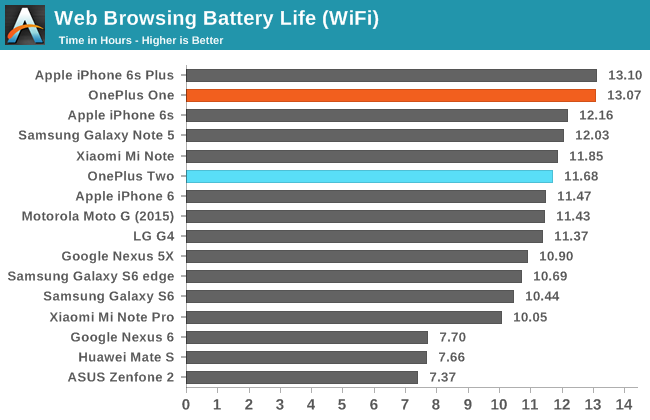
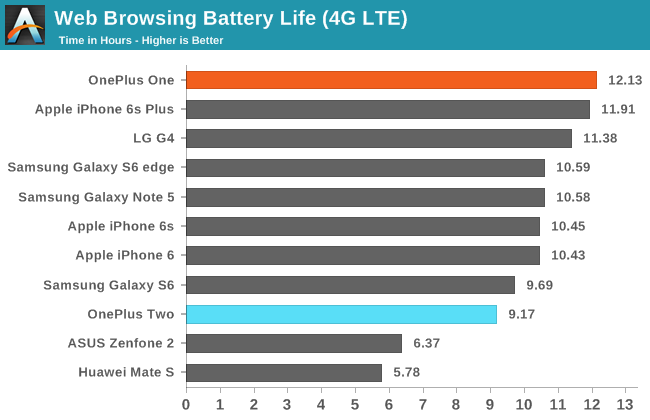
In our WiFi web browsing test there's definitely a noticeable regression in battery life going from the OnePlus One to the OnePlus 2, but both devices last over 11 hours so I don't think this presents a major issue. Battery life on LTE sees a more significant drop than the OnePlus One did, but it's worth noting that it's difficult to keep this test entirely consistent between editors due to different network frequency and signal strength in different nations, and so it's just to give an idea of what to expect when browsing off of WiFi.
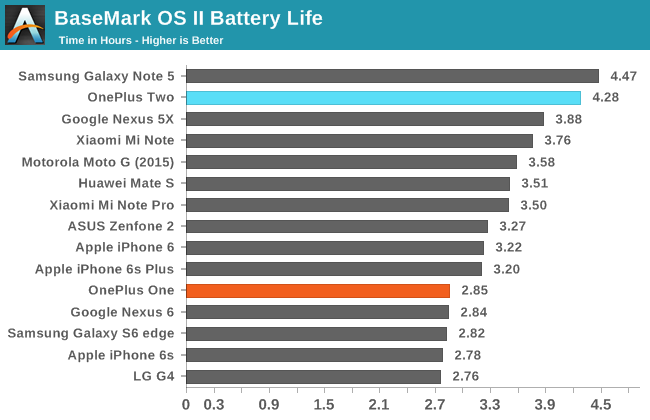
At first glance, the OnePlus 2 appears to do quite well in BaseMark OS II's battery test. When examining the behavior of the CPU during this test it's clear that the Cortex A57 cores shut off after about five minutes, and so you're left with four Cortex A53 cores. With that in mind, being able to run a CPU heavy workload for 4.28 hours is not that impressive when you have a 12.54Wh battery pushing four Cortex A53s.
It's worth comparing to the OnePlus One, which actually was a case of a device achieving both a high level of CPU utilization and high performance, and while it didn't last as long as the OnePlus 2 it's definitely more useful to sustain high CPU performance and achieve a shorter battery life than to sustain much lower performance for an hour and a half longer.
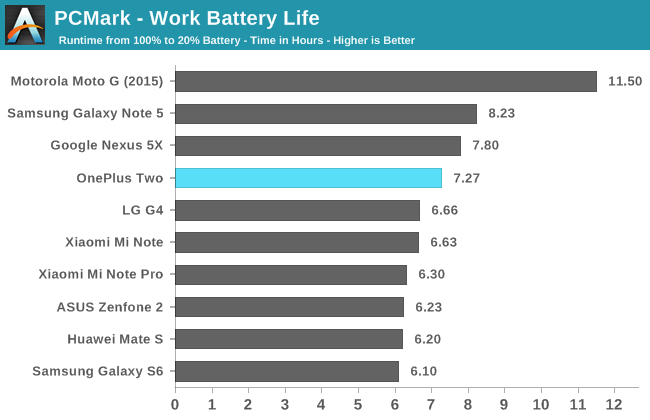
PCMark is a test that we actually weren't able to run on the OnePlus One due to the PCMark suite being a relatively new introduction to our benchmarking catalog. While this means we can't compare the OnePlus 2 directly to its predecessor, the fact that a device still needs to stand on its own means that this isn't necessarily a big deal. When looking at the OnePlus 2's battery lifetime of 7.27 hours it's clear that it has a notable lead over most other smartphones, although it's bested by the smaller Nexus 5X and the larger Galaxy Note5.
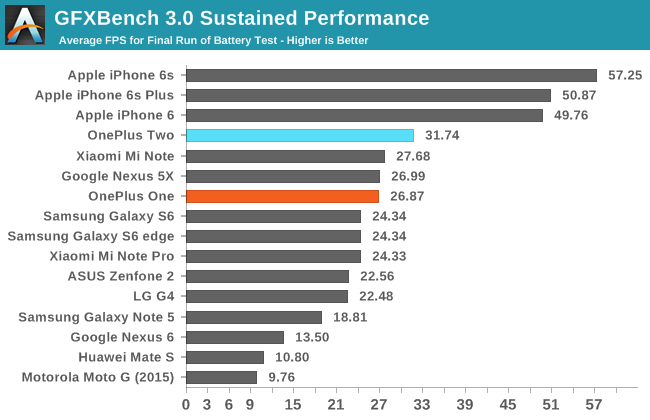
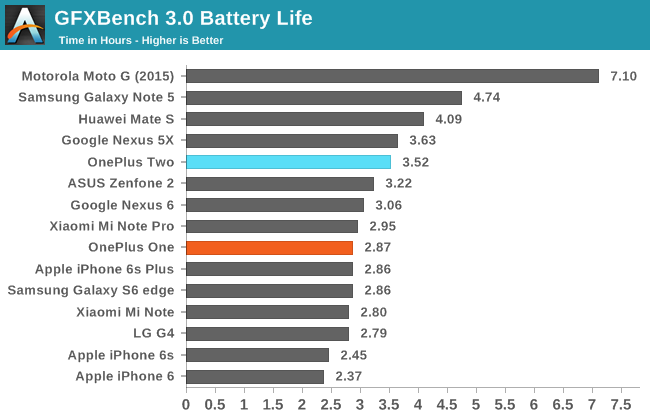
The fact that Adreno 430 is quite a good GPU coupled with a large battery allows the OnePlus 2 to perform very well in GFXBench's battery life test. When looking at sustained performance we see that after about 10 minutes it has dropped to around 32fps, and it sustains a very stable frame rate for the reminder of the test which speaks well of the thermal management going on. This is enough to put it at the top of the Android devices on our sustained performance chart, although it's still bested by Apple's latest and previous generation iPhones, which is partially due to the fact that the test renders on screen, although mostly due to A9's relative lack of GPU throttling. It lasts 3.52 hours before dying, which is one of the longer battery lifetimes that we've seen. One can safely say that the OnePlus 2 is a good phone for someone who wants to be able to run GPU heavy apps like games for a long period of time, although it's important to consider whether the CPU performance issues will end up bottlenecking performance in real world games.
While the OnePlus 2 is certainly not the most performant smartphone, one can say that the battery is more than enough to get you through the day. The performance and battery life demonstrated in GPU heavy workloads is notable, although the battery life in CPU heavy workloads is not very impressive once you consider how the phone is simply shutting off its Cortex A57 cores. If you need a balance between performance and battery life I would probably look elsewhere, but if battery life regardless of other factors is your priority when buying a device the OnePlus 2 will be a good fit.
Charge Time
One of the concerns that I've seen about the OnePlus 2 since its original announcement was the lack of support for Qualcomm's Quick Charge protocol. Since the OnePlus 2 has fairly substantial battery life, I don't think the lack of support for QC2.0 is a big problem, as you'll typically just be plugging the phone in at night. That being said, there aren't really any circumstances where quick charging makes the experience worse, and so the omission is a bit concerning.
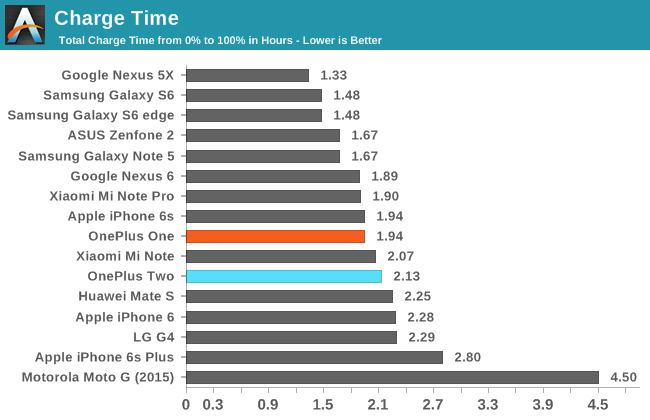
Charge time on the OnePlus 2 increases slightly from the OnePlus One, which isn't surprising given the slight bump in battery capacity. The charger that OnePlus includes in the box is a 5V 2A block, and as I mentioned above there's no official support for faster rates using QC2.0 chargers. For me, a two hour charge time isn't very bothersome considering the large battery, but I know that some buyers will take issue with the lack of QC2.0 support. The phone's tagline is "Never Settle" after all, so I think it's a valid point of frustration.
WiFi Performance
The OnePlus One used Qualcomm's WCN3680, which provided 1x1 802.11ac connectivity and Bluetooth 4.0 support. while the OnePlus 2 adopts their QCA6164A WiFi + Bluetooth chip which also supports 1x1 802.11ac and Bluetooth 4.0, although the software stack now supports Bluetooth 4.1 for improved LTE coexistence among other improvements. As far as WiFi performance goes, we're looking at the same theoretical peak throughput for both phones.
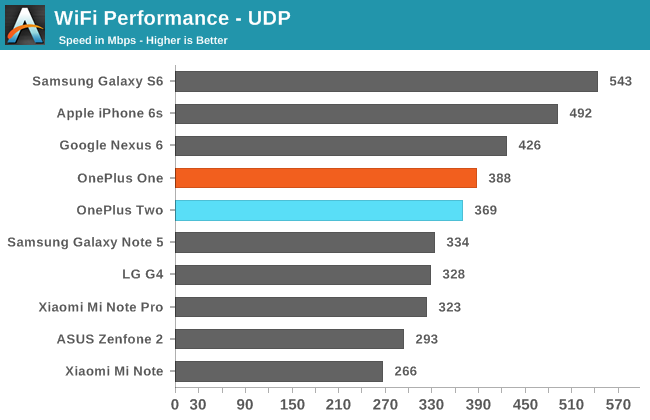
While there is a small gap between the results for the OnePlus 2 and OnePlus One, I'm sure if I ran the test many times I could eventually reverse the order due to testing variance. I think it's safe to say that the WiFi on the OnePlus 2 is as performant as its predecessor, and while it's not a 2x2 802.11ac implementation I think that you'll run into NAND or network limitations before the throughput of the WiFi chipset becomes a limiting factor.


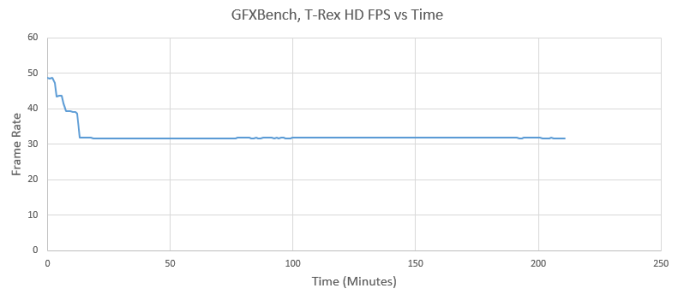








132 Comments
View All Comments
grayson_carr - Monday, December 14, 2015 - link
Here's my review. I owned a Moto X Pure for a couple months. Then I got a Nexus 5X. Now I'm selling the Moto X Pure. The Moto X Pure is fast in the sense that it opens and switched between apps quickly, but slow in the sense that its GPU has a tough time pushing that QHD resolution and it often has trouble maintaining a high framerate when scrolling in apps. The Nexus 5X is the opposite, which I vastly prefer. The 5X takes a little longer to open apps than the Moto X Pure, but it feels much smoother when scrolling in most apps and is better at maintaining a high framerate. Also, the Nexus 5X has an awesome fingerprint sensor, a vastly better camera in low light, faster updates, and a better calibrated screen (even with the Moto X Pure display in standard mode and not vivid). Battery life is similar between the two. The two things the Moto X Pure does have going for it over the Nexus 5X is build quality (which is very solid) and the speakers (which are excellent).Landiepete - Friday, December 18, 2015 - link
I can do that right now for you.1. It does not have a ingerprint scanner so if you absolutely want one, walk away.
2. It doe not have wireless charging, so if you feel plugging it in to a wall socket is too much trouble walk away.
What it DOES do :
1. With marshmallow, battery life is about 2 days for me. If you use it intensively, I gather you will have to charge it every day
2. The screen is excellent
3. It's not metal, but it does not feel cheap
4. The memory card is a great way to increase storage without paying the premium handset manufacturers charge for built in storage
5. It DOES get warm to the touch if you use the fast cores, like when it upates or you use 4K filming, but it won't burn your paws
6. Contrary to popular belief, the 808 is NOT too slow for the quad res screen. Caveat : I do not use it as a gameboy.
7. Near stock droid, so no crapware or bloatware. I don't edit movies on my Phone.
8. Very good camera
9. It still has the usual USB connector, so your old chargers and car kits still work
Conclusion : unless your prime goal is to sollicit oohhhs and aaaahhhs from onlookers, I thoroughly recommend it.
Pete
aijazz - Monday, December 14, 2015 - link
would be great to get a much awaited nexus 6p review.Devo2007 - Monday, December 14, 2015 - link
Given how late this review is, you'll probably be waiting until February.... :PBrandon Chester - Monday, December 14, 2015 - link
The Nexus 6P review is being done by Andrei and is almost complete. Look for it this week.mcbhagav - Monday, December 14, 2015 - link
<bait> Moto X Pure seems to be favorite among the kinda of users visit your site </bait>amdwilliam1985 - Monday, December 14, 2015 - link
thank you for the heads up, looking forward to the 6P review.I'm so glad I've got the 6P instead of OP2 :)
When in doubt, go with Nexus ;)
zeeBomb - Tuesday, December 15, 2015 - link
Thusday / Friday, lets get it!Nexus6P - Monday, December 14, 2015 - link
Maybe one day a review of me will be posted.LemmingOverlord - Monday, December 14, 2015 - link
You, Sir, are in that unique classe of "smartassphones" :D